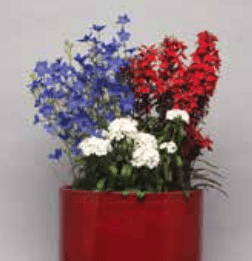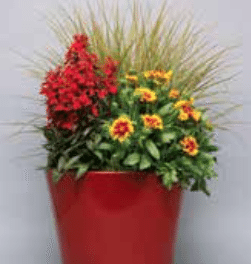
Perennial Solutions: Lobelia Starship Series
Just one look at the Starship series of lobelia and you’ll understand just how impressive and out-of-this-world these cultivars are. ‘Starship Deep Rose’ has stunning deep pink flowers and ‘Starship Scarlet’ has eye-catching red flowers. These new Starship cultivars from Kieft Seed offer many improvements over previous varieties. They are very uniform with a well-controlled habit and great branching, bloom early and produce high-quality plants.
Like many types of perennial cardinal flowers, the Starship series is hardy throughout Zones 6 to 10. They can be grown in average to moist soils. Since they are water lovers, the Starship series is well suited for using in rain gardens or for landscaping around ponds, streams and other moist areas, but avoid placing them in locations with standing water. Otherwise, they still offer strong performance in more traditional settings such as in perennial beds and border plantings. Generally, lobelia can be grown in full sun to partial shade; however, some shade is beneficial when they are placed in drier locations.
These first year flowering perennials stand 20 to 24 inches tall when blooming, but have a very narrow habit often growing just eight to 10 inches across. This gives them a great columnar appearance packing lots of color into very little garden space. The eye-catching spires of color appear in the early summer and last for a long time; blooming continues until mid fall in most locations. The butterfly-shaped blooms will not only get your attention, but bees, butterflies and hummingbirds are also attracted to the Starship series. However, deer must not see the beauty of this plant and tend to stay away from lobelia.
With their sturdy, maintenance-free growing habit, the Starship series provides an attractive, bushy and columnar appearance without the need for any pruning or staking. They provide impressive displays of color in the landscape, in premium containers, mixed containers or in a vase. Consider trying these great new lobelia cultivars.
Propagation
The Starship series can easily be started from seed. To improve the accuracy of sowing and the germination rates, the seed is pelleted. Sow one to two pellets into small plug sizes (288 cell) and three to four pellets into larger sizes (84 cell or larger). Covering is not required and light is beneficial for germination. Keep the soil wet during stage 1 (level 4), maintain soil temperatures of 65 to 72o F and provide high humidity (greater than 95 percent) until germination occurs. With these conditions, germination will usually occur in seven to ten days. Once they are germinated, the temperatures can be reduced to 60 to 65° F and the moisture levels allowed to dry out slightly (level 3) before watering.

is a breathtaking component in the landscape and premium containers.
Fertilizers can be applied when the true leaves begin to develop, applying 100-ppm nitrogen every irrigation, using a balanced water-soluble source with micronutrients. To prevent premature flowering, all stages of plug production should occur under short day lengths, preferably between 10 and 12 hours. ‘Starship Scarlet’ will reach a transplantable size in plugs in seven to nine weeks. ‘Starship Rose’ takes slightly longer — eight to 10 weeks.
Production
With its narrow growing habit, it’s usually best to plant multiple liners into each container; plant one plug per pot into small container sizes (5 inch or smaller), one to two plugs into 1-gallon containers and three to four plugs into 2-gallon pots. After transplanting, the growing medium of the pot should be even with the top of the plug. Cardinal flowers perform best when grown in a moist, well-drained medium with a slightly acidic pH: 5.8 to 6.2.
Lobelia do not tolerate saturated or overly dry growing conditions. Keep them moist, but not consistently wet. When irrigation is necessary, I recommend watering thoroughly then allowing the soil to dry slightly between waterings. Cardinal flowers have moderate fertility requirements. When using water-soluble fertilizers to deliver nutrients, apply 100- to 150- ppm nitrogen with every irrigation or 250 ppm as needed. Controlled-release fertilizers can also effectively deliver nutrients when incorporated into the growing medium prior to planting at a rate equivalent to 0.9 to 1.1 pounds of elemental nitrogen per yard of growing medium or applied as a top-dress onto the media surface using the medium labeled rate.
The Starship series has a sturdy growth habit and grows about half the height of other cultivars on the market. It is not usually necessary to use plant growth regulators during production to produce high-quality plants. However, if additional toning is desired, spray applications of 30-ppm paclobutrazol (Bonzi, Paczol or Piccolo) or 5-ppm uniconazole (Concise or Sumagic) can be applied. Typically, one or two applications applied early in the production cycle (just as the flower spikes are beginning to elongate) will suffice. Pinching is not necessary.
Temperatures and Scheduling
The Starship series naturally flowers in the early summer, but can be easily produced for earlier sales in bloom. They are first year flowering perennials. Although they can be successfully overwintered in some climates, they can be easily grown in a single growing season. Vernalization is not required.
As mentioned above, it is best to produce the liners under short day lengths to prevent pre- mature flowering. Liners that have been grown under long day lengths also tend to be weaker and have thinner stems. When possible try to utilize plugs which have been grown under short days and do not have flowers present. If the plugs have been grown under long days or flower initiation has occurred, it would be beneficial to plant multiple plugs into the containers to produce fuller, higher quality finished containers. Additionally, it is often beneficial to provide a couple of weeks of short day lengths after potting to help them bulk up (planting them a couple of weeks before the day lengths are naturally long will accomplish the same thing).
Starship varieties are facultative long day plants; flowering will occur faster when they are grown with day lengths greater than 13 hours. Photoperiodic lighting (day extension or night interruption) can be used to provide long day lengths when the days are naturally short. For early season sales, it takes 12 to 16 weeks from the onset of long days to flower when they are grown with temperatures of 60 to 65° F.
Insects and Disease
Be on the lookout for aphids, leafhoppers, leafminers, slugs, snails, two-spotted spider mites, Western flower thrips. Of these, aphids and whiteflies are the most prevalent. Although there are several insects that feed on lobelia, they can generally be grown without significant damage.
There are several diseases that cardinal flowers are susceptible to, including Botrytis, crown and root rots (Pythium, Phytopthora and Sclerotium), leaf spots (Cercospora, Colletotrichum, Phlyllosticta and Septoria), rust and Sclerotinia. Good cultural practices such as irrigation management, proper plant spacing and plenty of air circulation greatly reduce the occurrence of most of these diseases. Routine scouting is useful and recommended to detect the presence of insect pests and plant diseases early, allowing the appropriate control strategies to be implemented before significant crop injury or mortality occurs.
Availability
The Starship series of lobelia is brought to the market by Kieft Seed (www.kieftseed. com). To obtain seed, contact your Ball sales representative (www.ballhort.com). Plug flats can also be obtained through your Ball sales representative or various reputable perennial plant brokers and propagators.


 Video Library
Video Library 




















